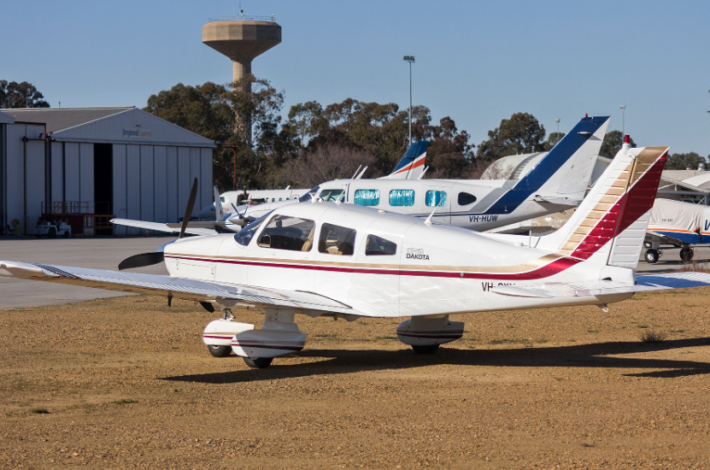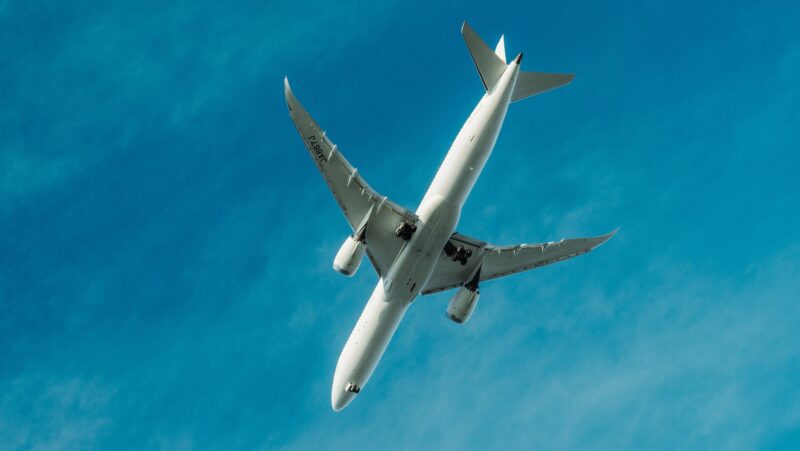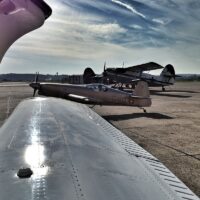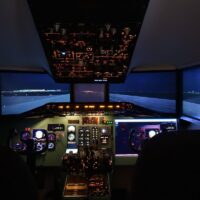
The Piper PA-28-236 Dakota (PD) is a single-engine high-wing aircraft produced by Piper Aircraft, renowned for its performance, versatility, and reliability. With its elegant design, advanced avionics, and comfortable cabin, the Dakota has gained popularity among private owners and flight training institutions.
Performance
PD is equipped with a Lycoming IO-360-C1C6 engine, delivering 235 horsepower, which provides excellent climb performance and cruising speed. It achieves a maximum cruising speed of 137 knots (252 km/h) and has a range of approximately 753 nautical miles (1,394 km), ensuring efficient and comfortable long-distance flights.
Impressive fuel efficiency, combined with a maximum takeoff weight of 2,440 pounds (1,107 kg), allows for extended flights with fewer refueling stops, making it an ideal choice for cross-country trips over varied terrain.
Specifications
| Specification | Value |
|---|---|
| Manufacturer | Piper Aircraft |
| Type | Single-engine, high-wing airplane |
| Crew Capacity | 1-2 (pilot and co-pilot) |
| Passenger Capacity | Up to 3 passengers |
| Length | 24.11 feet (7.35 meters) |
| Wingspan | 35.11 feet (10.7 meters) |
| Height | 8.92 feet (2.72 meters) |
| Wing Area | 170 square feet (15.8 square meters) |
| Maximum Takeoff Weight | 2,440 pounds (1,107 kilograms) |
| Maximum Landing Weight | 2,440 pounds (1,107 kilograms) |
| Maximum Payload | Approximately 1,000 pounds (453 kilograms) |
| Fuel Capacity | 72 gallons (273 liters) |
| Engine | Lycoming IO-360-C1C6 |
| Horsepower | 235 hp |
| Maximum Cruise Speed | 137 knots (252 kilometers per hour) |
| Range | Approximately 753 nautical miles (1,394 kilometers) |
| Service Ceiling | 14,000 feet (4,267 meters) |
| Rate of Climb | 715 feet per minute (3.63 meters per second) |
| Avionics | Garmin GNS 430 GPS/NAV/COM Unit, Multifunction Display (MFD), Altitude Preselect System, Automatic Direction Finder (ADF), Transponder |
| Seating Capacity | Up to 4 occupants (including pilot) |
| Cabin Length | 10.2 feet (3.1 meters) |
| Cabin Width | 3.8 feet (1.2 meters) |
| Cabin Height | 3.8 feet (1.2 meters) |
| Baggage Capacity | 200 pounds (90 kilograms) |
| Construction | All-Metal Airframe |
The specifications provide an overview of the size, weight, characteristics, avionics, and cabin of the PA-28-236. They highlight Dakota’s versatility and reliability for various applications in general aviation. It’s important to note that these specifications may vary slightly depending on the specific airplane configuration and optional equipment.
| Specification | Value |
|---|---|
| Manufacturer | Piper Aircraft |
| Type | Single-engine, high-wing airplane |
| Crew Capacity | 1-2 (pilot and co-pilot) |
| Passenger Capacity | Up to 3 passengers |
| Length | 24.11 feet (7.35 meters) |
| Wingspan | 35.11 feet (10.7 meters) |
| Height | 8.92 feet (2.72 meters) |
| Wing Area | 170 square feet (15.8 square meters) |
| Maximum Takeoff Weight | 2,440 pounds (1,107 kilograms) |
| Maximum Landing Weight | 2,440 pounds (1,107 kilograms) |
| Maximum Payload | Approximately 1,000 pounds (453 kilograms) |
| Fuel Capacity | 72 gallons (273 liters) |
| Engine | Lycoming IO-360-C1C6 |
| Horsepower | 235 hp |
| Maximum Cruise Speed | 137 knots (252 kilometers per hour) |
| Range | Approximately 753 nautical miles (1,394 kilometers) |
| Service Ceiling | 14,000 feet (4,267 meters) |
| Rate of Climb | 715 feet per minute (3.63 meters per second) |
| Avionics | Garmin GNS 430 GPS/NAV/COM Unit, Multifunction Display (MFD), Altitude Preselect System, Automatic Direction Finder (ADF), Transponder |
| Seating Capacity | Up to 4 occupants (including pilot) |
| Cabin Length | 10.2 feet (3.1 meters) |
| Cabin Width | 3.8 feet (1.2 meters) |
| Cabin Height | 3.8 feet (1.2 meters) |
| Baggage Capacity | 200 pounds (90 kilograms) |
| Construction | All-Metal Airframe |
These specifications present a brief overview of the size, weight, characteristics, avionics, and cabin of PD. They cover the essential details of the airplane and its capabilities for general aviation operations.
Safety Features
| Safety Features | Description |
|---|---|
| All-metal Airframe | Sturdy construction providing strength and durability |
| Advanced Lighting | Wingtip strobe lights, landing lights, and an anti-collision beacon for increased visibility |
| Dual Brakes | Enhanced braking power and control during landing and taxiing |
| Stall Strips | Improves low-speed handling and prevents stalls |
| Robust Electrical System | Reliable electrical system for proper functioning of avionics and lighting systems |
| Safety Belts and Restraints | High-quality seat belts and restraints for all occupants |
| Fire Protection System | Extinguisher system to suppress and control fires in the engine compartment |
| Emergency Locator Transmitter (ELT) | Activates in emergencies, transmitting distress signals for search and rescue operations |
| Optional Weather Radar | Real-time weather information for navigating around hazardous weather conditions |
| Safety Training | Comprehensive training for proper operation, emergency procedures, and accident prevention |
These safety features contribute to the overall reliability and security of the Piper Dakota, ensuring a safe and protected flight experience.
Interior and Comfort
The PA-28-236 model offers a comfortable and well-designed interior that prioritizes the comfort of both pilots and passengers.
Here are the key aspects of PD’s interior and comfort:
- Spacious cabin: The Dakota boasts a spacious cabin that comfortably accommodates up to four individuals. Ample headroom and legroom allow passengers to stretch out and relax during the flight, reducing fatigue;
- Ergonomic seats: PD seats are ergonomically designed to provide excellent support and comfort during long flights. Cushions and adjustable features allow pilots and passengers to find their desired positions;
- Ample storage space: The airplane is equipped with a generous amount of storage compartments, including overhead and baggage compartments, allowing passengers to conveniently stow their personal belongings and carry-on items;
- Large windows: PD’s large windows provide panoramic views of the surrounding landscape, enhancing the flying experience. Additionally, these windows allow natural light to fill the cabin, creating an atmosphere of openness and spaciousness;
- Soundproofing: PA-28-236 is equipped with soundproofing materials that reduce noise levels in the cabin. This feature enhances comfort and improves communication by minimizing engine and wind noise, providing a quieter and more enjoyable flight;
- Climate control: An efficient climate control system is installed in the airplane, maintaining a comfortable temperature in the cabin throughout the flight. This feature ensures pleasant conditions regardless of external weather conditions;
- Interior lighting: The airplane features well-positioned interior lighting that provides sufficient illumination for reading, working, or completing tasks during the flight. The lighting system can be adjusted according to individual preferences, creating a comfortable atmosphere during nighttime flights;
- Quality materials: PD’s interior is crafted using high-quality materials, including premium upholstery and finishes. Attention to detail enhances the overall aesthetics of the cabin, creating a sense of luxury and refinement;
- Accessibility: This plane is designed with convenience in mind. Wide cabin doors and strategically located entry points facilitate easy boarding and disembarking of passengers, ensuring a hassle-free experience.
The interior and comfort of PD create pleasant and comfortable conditions for both pilots and passengers. Whether it’s short flights or extended journeys over varied terrain, the interior design and comfort of the plane contribute to relaxation and satisfaction during the flight.
Avionics
| Avionics Features | Description |
|---|---|
| Garmin GNS 430 | GPS/NAV/COM unit providing precise navigation and communication capabilities |
| Altitude Preselect | Allows pilots to set and maintain a specific altitude, enhancing precision and ease of vertical navigation |
| Automatic Direction Finder (ADF) | Provides additional navigation aid, particularly for non-GPS navigation |
| Multifunction Display (MFD) | Offers comprehensive flight information and situational awareness in a single display |
| Optional Autopilot | Enables precise and hands-free control of the airplane’s flight path, enhancing pilot workload management and reducing fatigue |
| Transponder | Equipped with a transponder for altitude reporting and aircraft identification in air traffic control systems |
| Engine Monitoring System (EMS) | Monitors engine parameters such as temperature, pressure, and fuel flow, providing real-time data for efficient engine management |
| Communication Radios | Includes COM radios for clear and reliable communication with air traffic control and other airplanes |
| Navigation Radios | Incorporates NAV radios for accurate navigation and approach procedures |
| Flight Instruments | Features standard flight instruments such as an airspeed indicator, altimeter, vertical speed indicator, and attitude indicator |
| Weather Radar (Optional) | Optional weather radar system for real-time weather information and detection of hazardous weather conditions |
These avionics features enhance the pilot’s situational awareness, improve navigation capabilities, communication, and overall flight management of PD. The use of modern and advanced avionics ensures safety and efficiency in flight operations.
Flight Characteristics
The plane possesses favorable flight characteristics that make it popular among pilots. Here are the key flight characteristics of PD:
- Stability: PD is known for its stability in both straight and level flight as well as during maneuvers. It maintains a steady position, providing smooth and predictable flight experiences;
- Control responsiveness: The control surfaces of the airplane, including the ailerons, elevator, and rudder, are highly responsive. Pilots can rely on precise control and quick maneuverability;
- Good low-speed handling: PD performs well at low speeds, making it suitable for various flight operations, including takeoffs, landings, and pattern flying. The airplane maintains good controllability and demonstrates minimal adverse yaw in slow flight;
- Crosswind capability: The plane exhibits good control characteristics in crosswind conditions. With proper piloting techniques and coordinated actions during landing, pilots can maintain control of the airplane in crosswind situations;
- Cruising capabilities: PD possesses a decent cruising speed, allowing for efficient and timely travel between destinations. The combination of cruising speed and range makes it suitable for both short and long flights over varied terrain;
- Rate of climb: PD demonstrates excellent climb performance, efficiently reaching cruising altitude. The airplane exhibits a good rate of climb, enabling rapid ascent and quick attainment of desired altitudes;
- Visibility: The high-wing configuration of the Dakota provides excellent visibility from the cockpit. Pilots have a wide field of view, enhancing situational awareness and facilitating traffic scanning and clear visual orientation;
- Stall characteristics: PD exhibits predictable stall characteristics, providing ample warning and recovery cues. Pilots can expect controlled stalls and straightforward recovery procedures;
- Fuel efficiency: The Piper Dakota is known for its fuel efficiency, ensuring cost-effective operations. Its efficient fuel consumption allows for longer flights with fewer refueling stops, reducing overall operational costs;
- Range and endurance: Thanks to its fuel capacity and efficient fuel consumption, the Dakota aircraft possesses sufficient range and endurance. Pilots can confidently plan longer flights, leveraging their endurance capabilities.
These flight characteristics contribute to the reputation of the Piper Dakota as a versatile and enjoyable aircraft to operate. Its stability, responsiveness, and efficiency make it a preferred choice for pilots seeking a reliable and capable airplane for various general aviation operations.

Resale Value
Over the years, Piper Dakota has consistently maintained a high resale value in the pre-owned aircraft market. While resale prices can fluctuate due to various factors, including market conditions and the specific condition of the airplane, there are several reasons why Dakota generally retains its value:
- Reputation: Piper Dakota has established itself as a reliable and versatile airplane. Its features, safety, and comfort make it an attractive choice for many pilots and flight schools. The plane’s solid reputation and positive reviews contribute to steady demand in the pre-owned aircraft market, thus supporting its resale value;
- Popularity: Dakota is widely recognized and widely used in the general aviation community. Its popularity ensures a consistent demand among buyers looking for a dependable single-engine airplane with proven capabilities. The increased demand helps maintain the resale value of Dakota;
- Availability of Parts and Maintenance: Piper Aircraft has a well-established network of authorized service centers and distributors, providing easy access to original parts and qualified maintenance professionals. The availability of parts and maintenance services enhances the overall value of Dakota, making it appealing to buyers;
- Established Market Presence: Dakota has been in production for many years, giving it an established presence in the market. The presence of used plane listings and historical sales data allows buyers and sellers to accurately assess its market value. Such transparency contributes to a stable resale value;
- Operational Characteristics and Versatility: Dakota’s operational features, including cruise speed, range, and payload capacity, make it suitable for various general aviation applications. Its versatility attracts a wide range of buyers, further increasing its resale value.
It is important to note that the resale value of a specific Piper Dakota plane can be influenced by factors such as its age, condition, maintenance history, equipment upgrades, and market dynamics. Consultations with aviation experts, and brokers, and the use of market research tools can provide more accurate and up-to-date information on the current resale value of PD in your region.
| Specification | Value |
|---|---|
| Manufacturer | Piper |
| Model | Dakota |
| Production Years | 1979 – 1994 |
| Crew Capacity | 1 |
| Passenger Capacity | Up to 5 |
| Maximum Operating Altitude | 17,500 feet |
| Normal Cruise Speed | 139 knots / 160 mph |
| Seats-Full Range | 559 nautical miles / 644 statute miles |
| Balanced Field Length | 1,185 feet |
| Landing Distance | 2,262 feet |
| Cabin Height | 3 feet 8 inches |
| Cabin Width | 3 feet 4 inches |
| Cabin Length | 9 feet 6 inches |
| Total Baggage Capacity | 26.00 ft^3 |
| Internal Baggage Capacity | 26.00 ft^3 |
| External Baggage Capacity | 0.00 ft^3 |
Piper Dakota Price
| Description | Value |
|---|---|
| Average Price for a pre-owned Piper Dakota | $259,450.00 |
| Loan Amount | $52,750.00 |
| Loan Term | 120 months |
| Monthly Interest | $219.79 |
| Payment per Period | $2,645.08 |
| Owner-Operated Hours per Year | 450 hours |
| Fuel Cost per Gallon | $6.75 |
| Total Variable Costs per Year | $90,787.50 |
| Total Fixed Costs per Year | $82,885.00 |
| Annual Budget | $173,672.50 |
| Cost per Hour | $385.94 |
Note that the provided values are based on the given information and should be used as examples only. Actual prices, costs, and financing terms may vary depending on factors such as location, market conditions, financing terms, and individual circumstances.
For precise and up-to-date information on prices and costs, it is always recommended to consult with financial institutions, aviation specialists, and market experts.
Maintenance and Operating Costs
Maintenance and operating costs are important factors to consider when evaluating an aircraft. Here are the key aspects of maintenance and operating costs for the Piper Dakota:
- Scheduled Inspections: The Piper Dakota follows a planned maintenance program, which includes scheduled checks such as annual inspections, 100-hour inspections (for commercial operations), and other periodic inspections. These checks ensure the airworthiness of the plane and compliance with regulatory requirements;
- Availability of Spare Parts: Piper Aircraft has an extensive network of authorized service centers and distributors, providing easy access to original parts and components. This availability minimizes downtime during maintenance or repairs, ensuring timely and efficient service;
- Qualified Technical Staff: There is a wide range of qualified technicians and maintenance specialists familiar with Piper airplanes, including the Dakota. The availability of qualified personnel ensures proper maintenance, repair, and inspection of the aircraft by professionals familiar with the specific model;
- Accessibility: The plane is known for its accessibility in terms of maintenance and operating costs. The airplane’s design and systems are relatively straightforward, making maintenance procedures less complex and reducing associated expenses;
- Fuel Efficiency: The PA-28-236 model has high fuel efficiency, allowing for longer flights with fewer refueling stops. Such fuel economy contributes to lower operating costs, especially for owners who frequently undertake flights over long distances or across rugged terrains;
- Insurance Costs: Insurance premiums for the Piper Dakota are generally reasonable, considering its safety, reliability, and popularity in the general aviation community. The specific cost of insurance may vary based on factors such as pilot experience, coverage options, and regional considerations;
- Depreciation: Like any other plane, PA-28-236 may experience depreciation over time. However, it has historically retained its value well in the pre-owned aircraft market due to its reputation as a reliable and efficient airplane. This can be a favorable factor when considering potential resale value in the future;
- Operational Efficiency: The operational characteristics of the Dakota, such as cruise speed and range, contribute to operational efficiency. With its fuel-efficient performance and the ability for long flights, PA-28-236 offers an economically efficient solution for private owners and flight training purposes.
It is important to note that specific costs for maintenance and operation can vary depending on factors such as aircraft usage, geographical location, individual airplane condition, and regulatory requirements. Owners and operators should consult with authorized service centers, aviation experts, and insurance companies to obtain accurate cost assessments tailored to their specific circumstances.
Overall, the maintenance and operating costs of the Piper Dakota, combined with its reliability and accessibility, make it an attractive choice for individuals and flight schools seeking an economical and efficient aircraft for general aviation purposes.
Is Piper Dakota a Good Plane?
Yes, the Piper Dakota is generally considered a good aircraft. It has earned a positive reputation in the general aviation community due to its operational characteristics, reliability, and versatility. Here are a few reasons why the Piper Dakota is often regarded as a good aircraft:
- Performance: PA-28-236 boasts impressive operational performance. It has a respectable cruise speed, good range, and fuel efficiency, providing efficient and enjoyable flights. Its noteworthy speed characteristics allow for a quick climb to cruising altitude;
- Safety: The plane is equipped with various safety systems to ensure the safety of the pilot and passengers. These include a metal airframe, modern lighting systems, dual brakes, stall strips, and a reliable electrical system. These safety measures contribute to a reliable and safe flight;
- Comfortable Cabin: PD offers a spacious and comfortable cabin that can accommodate up to four people. Ergonomic seating, ample head and legroom, large windows, and soundproofing materials contribute to a pleasant and comfortable flight experience;
- Avionics: The Dakota’s avionics suite includes the Garmin GNS 430 GPS/AV/COM system and an optional autopilot, providing enhanced navigation capabilities and situational awareness. These avionics systems increase pilot confidence and facilitate precise control during flight;
- Maintenance and Operating Costs: Dakota aircraft are known for their ease of maintenance and overall accessibility. The availability of spare parts, qualified technical staff, and fuel efficiency contribute to lower operating costs compared to some other aircraft in its class.
It’s important to note that individual preferences and specific requirements may vary among different pilots. It is recommended to conduct a thorough evaluation, including test flights and discussions with experienced pilots, to ensure that the PA-28-236 model meets your personal needs and flight goals.
Bottom Line
The Piper Dakota is a versatile and reliable aircraft that has proven itself in the field of general aviation. When considering its characteristics, operational qualities, safety features, comfort, avionics, maintenance, and operating costs, several key points stand out.
The Dakota’s operational capabilities, including a powerful engine, impressive climb rate, and fuel efficiency, make it an ideal choice for cross-country flights and various types of general aviation. Stability, responsive controls, and good low-speed handling contribute to a smooth and enjoyable flight.
Safety features play a crucial role in PA-28-236, prioritizing pilot and passenger safety. From its metal airframe to modern lighting systems and stall prevention measures, the aircraft emphasizes visibility, control, and accident prevention, providing a reliable and safe platform in the sky.
The interior features a comfortable and spacious cabin with ergonomic seating, ample storage space, panoramic views, and soundproofing. All of these elements create a pleasant atmosphere, reducing fatigue during long flights and enhancing overall comfort for everyone on board.
The advanced avionics suite, including the Garmin GNS 430 and optional autopilot, provides Dakota pilots with precise navigation, situational awareness, and control. The multifunctional display (MFD) further enhances the accessibility and management of flight information.
Maintenance and operating costs for the PA-28-236 model are favorable due to its ease of maintenance, availability of spare parts, and competitive pricing. Its fuel efficiency contributes to lower operating costs, making it an attractive choice for both private owners and flight schools.
The Piper Dakota demonstrates outstanding qualities that allow it to hold a prominent position in the general aviation market. Its performance, safety, comfortable cabin, modern avionics, and cost-effectiveness make this aircraft sought after by pilots seeking a reliable and versatile platform for various aviation endeavors. Whether for personal use, flight training, or cross-country travel, the Dakota reaffirms Piper Aircraft’s commitment to creating exceptional aircraft for general aviation purposes.

